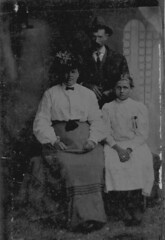Difference between revisions of "Ferrotype"
(date, mirror-imaged) |
|||
| Line 1: | Line 1: | ||
{{stub}} | {{stub}} | ||
| + | |||
| + | {{Flickr image | ||
| + | | image_source=http://www.flickr.com/photos/89864432@N00/3222977420/in/pool-camerapedia | ||
| + | | image=http://farm4.static.flickr.com/3474/3222977420_860f038975_m.jpg | ||
| + | | image_align=right | ||
| + | | image_text=tintype sample:<br/>American family | ||
| + | }} | ||
'''Ferrotypes''' (also known {in the USA} as '''Tintypes''') are photographs made onto black-enamelled iron plates by the [[wet-collodion ]]process. The black background made the transparent areas of the negative image appear black, and the dark, silvered areas were whitened using mercuric bichloride, and so appear light - in the same way as glass [[Ambrotype]]s. | '''Ferrotypes''' (also known {in the USA} as '''Tintypes''') are photographs made onto black-enamelled iron plates by the [[wet-collodion ]]process. The black background made the transparent areas of the negative image appear black, and the dark, silvered areas were whitened using mercuric bichloride, and so appear light - in the same way as glass [[Ambrotype]]s. | ||
Revision as of 21:27, 24 January 2009

|
| tintype sample: American family |
Ferrotypes (also known {in the USA} as Tintypes) are photographs made onto black-enamelled iron plates by the wet-collodion process. The black background made the transparent areas of the negative image appear black, and the dark, silvered areas were whitened using mercuric bichloride, and so appear light - in the same way as glass Ambrotypes.
French photographer Adolphe A Martin was the first to use this process, in 1853. A dry ferrotype processes later replaced the wet-plate system. As the process could be carried out inside the camera and needed no drying time, dry ferrotypes were popular with "while-you-wait" beach and street photographers[1].
Since the image must viewed from the silvered side of (non-transparent!) plate, the image is left-right reversed (mirror-imaged) - a fault shared with most Daguerreotypes.
The process was used in the US until the early 1940s.
- ↑ Focal Encyclopedia of Photography, Focal Press, 1976 edition, p.588